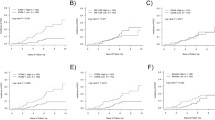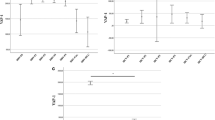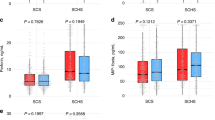Abstract
Intercellular adhesion molecule-I (ICAM-I) is a member of the immunoglobulin supergene family. It is expressed on the surface membrane of cells of multiple lineages at sites of inflammation. A soluble form of ICAM (sICAM-I) comprising the five extracellular Ig-like domains of ICAM-I has been detected in human serum and has been found to be increased in a variety of acute and chronic liver disorders. However, little is known about sICAM-I levels in children with chronic liver disease. Therefore, we measured sICAM-I in 23 children with chronic hepatitis, 14 children with cirrhosis, and 10 age- and sex-matched normal children by commercially available ELISA. We also correlated the sICAM-I levels with the histological activity index (HAI) score as determined from liver biopsies. Patients with chronic hepatitis had higher sICAM-I levels compared to controls (723 ± 272 ng/ml vs 282 ± 43 ng/ml, mean ± sd; P < 0.05). sICAM-I levels were also higher in patients with cirrhosis compared to controls (630 ± 218 ng, mean ± sd; P < 0.05). However, there was no significant difference between sICAM levels in patients with chronic hepatitis and cirrhosis. A significant correlation was found between the ICAM-I level and the histological activity index score in patients with chronic hepatitis (r = 0.58; P < 0.001) and in patients with cirrhosis (r = 0.7; P < 0.001). We also found that by using the cutoff level of 346 ng/ml, sICAM-I can be used as a screening test with high specificity (100%) and sensitivity (94%) to differentiate children with chronic liver disease from normal children. We conclude that sICAM is increased in children with chronic hepatitis and cirrhosis compared to controls. The degree of elevation correlates with the HAI score. sICAM may be used as a marker of the disease activity and may provide diagnostic and prognostic information in children with chronic liver disease. However, this needs to be further studied.
Similar content being viewed by others
REFERENCES
Springer TA: Adhesion receptors of the immune system. Nature 346:425–34, 1999
Nouri-Aria KT, Koskinas J, Portmann BC, Williams R: Serum intercellular adhesion molecule-I levels in chronic hepatitis C: Association with disease activity and response to interferon ? Gut 36:599–603, 1995
Makgoba MW, Sanders ME, Luce GEG, et al: Functional evidence that ICAL-I is a ligand for LFA-I in cytotoxic T cell recognition. Eur J Immunol 18:637–640, 1988
Van Seveneter GA, Shimizu Y, Horgan KJ, Shaw S: The LFA-I ligand ICAM-I provides an important costimulatory signal for T cell receptor-mediated activation of resting human T cell. J Immunol 144:4579–4586, 1990
Rothelin R, Mainolfi EA, Czaikowski M, Marlin SD: A form of circulating ICAM-A in human serum. J Immunol 147:3788–3793, 1991
Adams DH, Mainofli E, Burra P, et al: Detection of circulating intercellular adhesion molecule-I in chronic liver disease. Hepatology 16:810–814, 1992
Kojima T, Sasai M, Kobayashi Y: Increased soluble ICAM-I in tracheal aspirates of infants with dysplasia. Lancet 342:1023–1024, 1993
Knodell RG, Ishak KG, Balck WC, et al: Formulation and application of a numerical scoring system for assessing histological activity in asymptomatic chronic active hepatitis. Hepatology 1:431–435, 1981
Desmet VJ, Gerber M, Hoofnagle JH, et al: Classification of chronic hepatitis: Diagnosis, grading, and staging. Hepatology 19:1513–1520, 1994
Simpson KJ, Hayes PC: Soluble adhesion molecules in immune mediated liver disease. Gut 36:806–808, 1995
Lim AG, Jazraw RP, Ahmed HA, et al: Soluble intercellular adhesion molecule-I in primary biliary cirrhosis. Hepatology 20:882–888, 1994
Bergasa NV, Newman W, Rothlein R, et al: Serum levels of soluble adhesion molecules (ICAM-I, V-CAM I and ESelectin) are markedly elevated in primary biliary cirrhosis (PBC) and unaffected by low dose oral methotrexate treatment. Gastroenterology 104:A877, 1993
Author information
Authors and Affiliations
Rights and permissions
About this article
Cite this article
Abdalla, A., Sheesha, AA.G., Shokeir, M. et al. Serum Intercellular Adhesion Molecule-I in Children with Chronic Liver Disease: Relationship to Disease Activity. Dig Dis Sci 47, 1206–1208 (2002). https://doi.org/10.1023/A:1015393708187
Issue Date:
DOI: https://doi.org/10.1023/A:1015393708187




